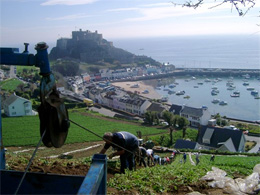
The Jersey Royal Company
.
.
.
.
- Vegetables by Name
- Potato (Jersey Royal)
|
CONTACT DETAILS TELEPHONE 01534 852444
|
 |
 |
 |
|
The Jersey Royal Company is a fully integrated produce company growing, grading, washing and packing Jersey Royal New Potatoes for UK retailers. Whilst employing many traditional production methods, we combine these with some of the most up-to-date technologies in potato production from around the world. The Jersey Royal new Potato is the only potato that carries the EU Protected Designation of Origin mark of authenticity. This was awarded in part, as a recognition of the unique methods of production.
|
||
 |
 |
 |
|
History of the Jersey Royal new potato The Jersey Royal new potato dates back over 130 years, is very much a part of the Island’s heritage and is widely sought after by locals, chefs and food aficionados alike. The first of arguably only three truly seasonal British lines of fresh produce alongside asparagus and strawberries, Jersey Royals are seen by many to herald the start of spring. In around 1880, local famer Hugh de la Haye is reported to have had an unusually large potato with 15 or 16 eyes. History relates that whilst discussing the potato with friends, they decided to cut it up and plant the pieces on a côtil above Bellozanne valley in the centre of the Island. One of the shoots yielded a kidney-shaped potato with very thin skin as opposed to a standard round one, and so the Jersey Royal was born. Recognising the unique shape of the new potato, it was first marketed as the Jersey Fluke, and it commanded a premium price on the wholesale markets. The addition of ‘Royal’ and the dropping of the name ‘fluke’ came in towards the end of Queen Victoria’s reign when imperialism was widespread, and many things were termed ‘royal’. From those early beginnings, the Jersey Royal is today the most significant agricultural export of the Island with around 35,000 tonnes sold annually.
|
||
 |
 |
 |
|
Seed Regeneration Programme Unlike other common varieties of potatoes, clean, virus-reduced Jersey Royal seed is not available ‘off the shelf’. The Jersey Royal has to manage all of its own seed stocks, and in order to create a rolling 9,000 tonne seed stock it has taken 6 years to develop. In 2008 The Jersey Royal Company took the decision to bring the whole process of seed regeneration in-house. This started by selecting several tubers from particularly good seed grown in the Island that was sent to SASA to be ‘cleaned’ of virus. The process starts with a single tuber that has a V-shaped notch cut out which contains one of the potato’s eyes. This eye is propogated under high care laboratory conditions to form a seedling that grows rapidly. The speed of growth means that the virus held in the cells of the mother tuber cannot migrate up the stem as quickly as the growth of the seedling, and as such the stem can be cut at nodes higher up the seedling that are ‘virus-free’. In practice, this has to be carried out several times over a 6 – 12 month period repeatedly cutting the stem from previous cutting until virus free seedlings are produced. – i.e. 1 cutting grows to 5 nodes over 5 weeks and produces 5 cuttings Roughly 15,000 cuttings can be produced over a 6 month period. These cutting are planted as a seedling by a seed propagator into seedling trays and grown under a glasshouse in controlled conditions until the form a root ball over a further 5-6 week period. From this stage, the seedling are pricked out into pots and grown on to mature potato plants that produce mini tubers. This takes approximately 4 – 5 months. Each seedling will produce approximately 4 – 5 mini tubers. Approximately 40,000 mini tubers can be produced from a single cutting over a 12 month period. The mini tubers are harvested in July / August and then stored through the dormant period, ready for planting out in open fields the following spring at a planting rate of 60,000 mini tubers per hectare. These first generation field crops are then multiplied up to form the seed crop for the next 3 years, and will eventually form the export crop for year 4. Planting The Jersey Royal new potato is the most famous brand in fresh produce and is renowned for being the first and tastiest new potato that heralds the start of spring. The very earliest crops are planted in December in glasshouses or polytunnels. All Jersey Royals are planted by hand, taking special care to make sure that the shoots are placed uppermost to ensure even and early emergence. The earliest outdoor fields planted are the very steep south facing coastal slopes called côtils. These côtils are planted in the first and second weeks of January. Because of their steepness, aspect and proximity to the coast the soil is generally light, free draining, warms quickly and has some frost resistance. The steepness of the fields means that they are unsuitable for machinery and so they are ploughed and planted using hand ploughs pulled by a winch cable from the top of the côtil. These fields are very labour intensive, produce the earliest potatoes and command the highest prices. The next fields to be planted are generally the lighter sloping soils of the western and southern coastal plains and the northern coastal fields. These are planted from mid January through to mid February. Planting then moves to the heavier inland soils which produce the later crops and the seed crops for the following year’s production. These fields tend to be larger and flat. Harvesting begins at the end of February in limited volumes from the glasshouses and polytunnels. Earliest outdoor crops are available from early April with peak volumes through May and June. Supply then continues through to the end of July. |
||
 |
 |
 |
|
Harvesting The crop is lifted as an immature, flaky-skinned product and is ready for harvest at around 12-13 weeks. The first indoor crops are lifted in February and the first outdoor côtil crops from the end of March through to late July. The seed crop is harvested in June and throughout July. The early côtils are hand-picked, having first been ploughed out of the ground using winch ploughs. The slightly less steep slopes are lifted with a tractor and small side-elevator digger (see below) and then hand-picked. The rest of the crop is lifted using single and twin row harvesters into bulk 1 tonne bins. At the peak of the season The Jersey Royal Company can be using up to forty harvesters at any one time. The loads of 6 to 8 bins are covered with tarpaulins and transported from the field to the packhouse within an hour of lifting for cooling, grading and processing. There are three harvesting teams (orange, green and blue) that are responsible for the west, north and central and east of the island respectively. The three teams are split into smaller units for specific operations and are responsible for the total management of the crops from planting through to harvest. Each team has a strategic base in their respective part of the island to minimise on traffic movement around the island roads, and all grading and packing is done at the main Jersey Royal site, Peacock farm. The Jersey Royal Company operates a one-way system between the fields and the packhouse as a CSR policy to avoid unnecessary congestion along the narrow island lanes. |
||
 |
 |
 |
